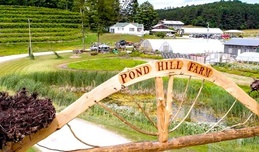Foie Gras
Oct. 17, 2007
A recent restaurant review in the Northern Express highlighted one local eatery’s Foie Gras specialty. That article resulted in some immediate calls, e-mails and letters to the editor expressing concern over this nearly 5,000-year-old culinary tradition.For those who might be unaware, Foie (pronounced Fwah) Gras is French for “fat liver,” in particular fattened duck or goose liver, that is created through the process of gavage (French for gorging or force-feeding). Foie Gras is among the most popular delicacies in French cuisine, and for years has been offered at fine dining establishments in the United States and throughout the world. The fattened liver results in rich, buttery flavors, and Foie Gras is often prepared into a mousse or paté.
LONG-STANDING CONTROVERSY
Now for the controversy, which has actually followed Foie Gras dating back to its development around 2500 BC, when the ancient Egyptians found that they could fatten geese by force-feeding them. After the fall of the Roman Empire, both the Celts and those of Jewish faith continued the Foie Gras tradition. In the 1400s, Judaic dietary law began to question the force-feeding process. By the late 1900s, Foie Gras disappeared from the Jewish diet, and the controversy ended.
The challenge with all controversies is that both sides have compelling justifications for their positions.
First of all, unless you are a farmer, hunter, or work at a production facility that processes animals for food, most of us have no idea how the food on our plates is raised and processed.
Most of us probably don’t want to know.
Then there is the challenge for all of us to sort through all of the propaganda that we are exposed to everyday. I recently profiled a beer from a major brewery only to receive e-mails from an environmental group suggesting that the genetically-altered ingredient the brewer was using is harmful to humans. The brewery’s response to me was that the brewing process destroys any potential harm to humans.
So who do we believe? What do we believe? One day, we read a medical study that something is harmful; the next day we read that what was harmful is now good for you.
The controversy around Foie Gras is quite a heated one. Having never been to a farm that raises geese or ducks for this purpose, I have no first hand account of the process. In calling area chefs, I received responses like “It is not a concern,” or “It’s a non-issue.”
Respected journalists from 60 Minutes and The New York Times have visited the largest Foie Gras farm in the United States, and their observations have been that the geese and the ducks willfully take to the overfeeding process.
At the same time, credible individuals from several animal rights organizations point to evidence of what they believe are inhumane practices and outright animal cruelty.
These animal rights organizations are succeeding in their efforts to stop the serving of Foie Gras. Chicago was the first major culinary community to ban the serving of Foie Gras. California has passed a law that will go into effect in 2011 banning Foie Gras there. Several European nations have also banned the serving and production of Foie Gras.
Foie Gras is a multi-million dollar industry and an important component to the French economy. Nearly 30,000 workers are connected to the industry, and France produces 80% of the Foie Gras consumed in the world (the United States produces about 2%). In many ways, the Foie Gras industry of France is similar to that of the American tobacco industry. Trying to shut it down overnight won’t be easy.
GAVAGE IS NO PICNIC FOR GEESE
The process of gavage, or force-feeding, is what is at issue here, though those in the Foie Gras industry argue that animal rights and vegetarian/vegan groups’ ultimate goals are to stop hunting and any raising and processing of animals for human consumption.
There are plenty of videos and photos of the Foie Gras gavage process on the web. Essentially, a 15-inch feeding tube is used to force-feed the goose or duck a few times a day. The process begins about six months prior to slaughtering the animals, with force-feeding of a corn mash taking place about four times a day for two to five weeks.
The result is a liver that swells to 10 to 12 times in normal size, and in some cases weighing up to three pounds, versus the normal three to four ounces.
Animal rights organizations believe (some of their members have gone undercover at both French and American Foie Gras farms) that this process of force-feeding is harmful to the animals and crosses the line of international acceptable practices for the raising of animals for food use. These critics point to exploding livers, the animal’s inability to walk, liver disease, and poor conditions of the farms and processing facilities.
The European Union Scientific Committee on Animal Health and Animal Welfare found the following in regards to the production of Foie Gras in ducks and geese:
“The birds’ livers become so enlarged… that according to documentation by veterinarians, the animals must experience unspeakable pain and suffering. The vast amounts of feed pumped down the ducks’ throats causes enormous internal pressure and birds have literally exploded from these forced feedings. The results of necropsies on dead birds that have been force-fed reveal ruptured livers, throat damage, esophageal trauma, and food spilling from the dead animals’ throats and out of their nostrils. Sometimes the pipe punctures the esophagus, causing many birds to die from choking on the blood that fills their lungs. Some birds choke to death on their own vomit, or become so weak that they are unable to fend off rats from eating them alive. In fact, because of the massive toll taken on the birds during the force-feeding process, the average pre-slaughter mortality rate is up to twenty times higher than on other duck factory farms.”
CHEFS STILL WANT THEIR FOIS GRAS
In 2004, several animal rights organizations banded together and solicited the American Veterinary Medical Association (AVMA) to take a position to recommend the banning of the production methods for Foie Gras.
The AMVA after an initial review released this statement: “Limited peer-reviewed, scientific information is available dealing with the animal welfare concerns associated with foie gras production, but the observations and practical experience shared by our members indicate a minimum of adverse effects on the birds involved.” One researcher from the AMVA pointed out that “this process (gavage) is less intrusive then using a rectal thermometer on a cat.”
While animal rights groups have won victories in Chicago and California, those are being challenged. Several chefs in Chicago refuse to comply with the ban, and there appears to be a lack of enforcement of the ban as well. There are lawsuits pending over the contitutionality of the law both in Chicago and California.
The owner of the largest Foie Gras operation in the United States has said he will move his operation to Canada if his home state of New York bans Foie Gras. So far, New York has not taken action; and legislators argue, as did Mayor Daley of Chicago, that there “are more pressing issues to deal with.”
In Northern Michigan, the chefs and restauranteurs I spoke with have received no backlash, boycotts, e-mails or customers complaining in-person to them since public protests and opposition began a decade ago. One chef put it to me this way: “These animals are being raised for slaughter. The fattening process happens with every animal raised for this reason. So what’s next, hogs and beef cattle?”
Another chef commented that he worked one summer in France at a Foie Gras farm, and said that ducks and geese do not have the throat gag reflex that other animals have, and that inserting the feeding tube was not intrusive. he also said that these types of tubes are used for feeding all types of animals medicine. to date only one Michigan restaurant (in St. Joseph) has publicly said that they will no longer serve Foie Gras.
So who is right? The debate is sure to continue for years to come. For me personally, I have enjoyed Foie Gras in various forms at several formal dinners and special events throughout Northern Michigan. I have been aware of the concern raised by animal rights organizations for several years, but that has not persuaded me to boycott Foie Gras on those rare occasions it is served to me. Though I must admit it troubles me when I see the pictures and the video of the process, and I never have had the stomach to be a hunter, so my opinions are mixed. I see arguments from both sides as valid.
As for you, here are a few resources to further your study of Foie Gras. For the side in favor of it, visit www.hudsonvalleyfoiegras.com, where Foie Gras farmer and advocate Michael Ginor offers a lot of information. To learn more about the concerns against Foie Gras practices, check out
www.nofoiegras.org.
Trending

Three Days of Art in Cadillac
The Cadillac Festival of the Arts kicks off on Thursday, July 17, with the Up North Arts Color Fun Run at 6pm at City Dock. … Read More >>
Adaptive Sailing
For this Beaches, Boats, & BBQ issue, we wanted to give a shoutout to Traverse Area Community Sailing (TACS) and their f… Read More >>
Pond Hill Turns 30!
Pond Hill Farm does a little bit of everything. It’s a brewery and a winery. A cafe and a market. A pizza joint and a … Read More >>


